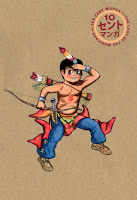Experiments in Manga has joined Manga Bookshelf! The site will no longer be updating at Blogger, so if you have bookmarks in place you may want to update them to http://experimentsinmanga.mangabookshelf.com/. Although I won’t be removing the old site, all of the content and comments have been moved to the new one. I’m hoping to make the transition as smooth as possible but I still have a bit of tidying up to do. I’ve tried my best to get everything to redirect properly, but if you notice anything missing or strange please do let me know. Thanks for your help and thanks for sticking with me! And now:
A huge welcome to new readers of Experiments in Manga and an even bigger thank you to returning readers!
My name is Ash Brown. I’m a musician by training, a librarian by profession, a blogger by choice, and a manga addict by nature. My interest in Japan and Japanese culture actually extends far beyond manga and includes other literature, art, music, language, food, and probably anything else you can imagine. I practice traditional Okinawan karate-do (specifically Shōrin-ryū and Shūdōkan) as well as kobujutsu. I also happen to be a member of a taiko ensemble. Oh, and I love riichi mahjong. I’m pretty bad at it, though.
My day job has absolutely nothing to do with manga (although once I did catalog a collection of underground and independent comics; that was pretty cool.) Experiments in Manga is a personal site that I write and maintain entirely in my free time. I would actually like to write more than I do, but unfortunately that free time is very limited. Besides, I like to spend some of my waking hours actually reading, too.
I started Experiments in Manga in 2010 (mostly for myself) as a way to interact with the manga blogging community to a greater extent and to help keep track of all the manga that I read. And I read a lot of manga. Depending on who you ask I either have a very eclectic taste or no taste at all. I’m extremely open-minded and difficult to offend. I read and enjoy manga from just about every genre and aimed at any demographic or audience.
What can you expect from Experiments in Manga? Typically, I release three or four posts a week, including the weekly My Week in Manga feature. I also write in-depth reviews, among other things. Not surprisingly, the primary focus of Experiment in Manga is on manga but I also cover Japanese literature and write about tangentially related subjects and other things that interest me as well. I currently hold a monthly manga giveaway which allows me to quite literally share my love of manga. It also gives me an excuse to make lists. I love lists.
I am absolutely delighted to be joining the Manga Bookshelf Battle Robot. I’ve been a devoted reader of Manga Bookshelf since I discovered the site and some of my most admired manga bloggers are associated with the group. I consider it a great honor to be invited to join. I’m truly looking forward to working with everyone at Manga Bookshelf and hope that readers (new and old) will find Experiments in Manga at least occasionally interesting or useful!






